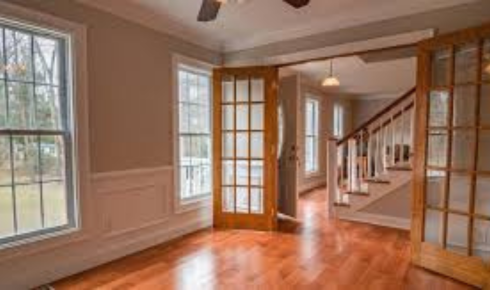Walk into any modern home store, and you’ll find endless options for doors and windows—aluminum, fiberglass, PVC, and all sorts of engineered materials promising durability and low maintenance. And sure, they have their place. But there’s something about real wood that those alternatives can’t quite capture. Maybe it’s the warmth, the texture, or just the timelessness of it. Wooden doors and windows feel alive in a way synthetic ones don’t. They don’t just shut out the weather; they invite in character.
I’ve noticed that homes with natural timber features often carry a different kind of presence. They’re not loud or flashy, but they feel grounded, almost like they’ve grown roots into the earth. And that feeling, that unshakable sense of belonging, comes largely from the little details—like a heavy wooden door that greets you each evening or a window that frames sunlight with quiet dignity.
A door that says, “Welcome home”
Doors are usually the first thing we touch when we enter a home. It sounds simple, but think about it—every knock, every turn of a key, every goodbye or homecoming runs through that doorway. That’s why the choice of a front door matters more than people admit.
There’s a reason architects and homeowners alike still gravitate toward Solid Timber Entrance Doors. They’re not just barriers between inside and outside. They’re statements. They have weight—literally and emotionally. You feel it when you swing one open, the reassuring heft that says, “This is built to last.” They weather storms, muffle noise, and pick up little marks and scratches that turn into stories over the years. Unlike hollow-core or composite doors, solid timber doesn’t try to hide its character; it leans into it.
And then there’s the curb appeal. A front door with genuine timber grain can completely shift how a home feels from the street. It can be rustic, elegant, or minimal, but it always whispers authenticity. Paint might cover it, sure, but the soul of the wood still lingers underneath.
Windows that frame more than light
If doors are handshakes, windows are glimpses of a home’s soul. They don’t just keep the rain out; they frame the world. And there’s a reason why wooden-framed windows have stuck around for centuries despite newer alternatives flooding the market.
Timber Frame Windows carry a kind of warmth that aluminum or plastic simply can’t replicate. They’re tactile, they age gracefully, and they make rooms feel less sterile. You can run your hand along the frame and sense the craft behind it. They’re also surprisingly practical—timber is a natural insulator, which means it keeps heat in during winter and out during summer. That little bit of efficiency adds up, especially in older homes where character sometimes comes at the expense of comfort.
Of course, wood needs maintenance. It asks for care—occasional sanding, a new coat of finish now and then—but isn’t that part of the charm? In a world where everything is “maintenance-free,” we’ve almost forgotten the joy of looking after something and watching it repay us with decades of service.
The sustainable side of timber
One argument often made against timber is deforestation. But here’s the other side: when sourced responsibly, timber is one of the most sustainable building materials on earth. Trees grow back. Steel and plastic don’t. A responsibly managed forest is a renewable resource, absorbing carbon even as it provides material for homes.
And then there’s longevity. A well-cared-for timber door or window can outlast multiple generations of cheaper alternatives. Think of the old farmhouses and cottages across Europe still standing with their original woodwork intact. Compare that with plastic windows that yellow, warp, or get replaced every couple of decades. Sustainability isn’t just about where the material comes from—it’s about how long it lasts.
The emotional thread we don’t talk about enough
There’s also something less tangible that makes wood special. It’s not just design or durability; it’s emotion. Wood carries history. It creaks when the seasons change, smells faintly of varnish or sap, and darkens in tone as it grows older. These aren’t flaws—they’re the natural storylines of a material that refuses to be static.
Think about a front door polished by thousands of hands over decades, or a windowsill where the paint has chipped from sunlight and plants resting year after year. Those little imperfections give a home warmth and identity. No engineered product has figured out how to age so gracefully.
Blending tradition with modern life
That said, timber doesn’t mean you’re locked into an old-fashioned aesthetic. Modern design has embraced wood in clever, subtle ways. A contemporary home might pair sleek glass with chunky timber beams, or a minimalist townhouse might feature clean-lined wooden doors with matte finishes.
Technology also helps. Today’s treatments make timber more resistant to moisture, pests, and wear. So, you get the soul of wood with less worry. It’s the best of both worlds—heritage charm with modern convenience.
Why the details matter
Here’s the thing: doors and windows are often treated like afterthoughts in home design, chosen last, squeezed into a budget, or swapped for whatever’s easiest to install. But they’re the parts of a house we touch and interact with every single day. They set the tone, not just aesthetically but emotionally.
Investing in wood—whether it’s a sturdy entrance door or a set of hand-finished window frames—isn’t just about style. It’s about choosing materials that reward you daily, in little tactile ways, and remind you that home is more than walls and a roof.
Wrapping it up
At the end of the day, homes built with real wood in their bones tend to feel richer. Not richer in cost, necessarily, but richer in experience. They tell stories through their grain, carry warmth through their presence, and remind us that building materials don’t have to be sterile to be practical.
Yes, they demand care. Yes, they may cost a little more upfront. But in exchange, they give back tenfold—in comfort, character, and longevity. Whether it’s the weight of a solid timber door under your hand or the golden light spilling through a wooden window frame at sunset, these details anchor us.
Because when it comes down to it, a home isn’t just where you live—it’s how it makes you feel. And nothing makes a house feel more like home than wood that has been shaped, cared for, and allowed to grow old with you.

